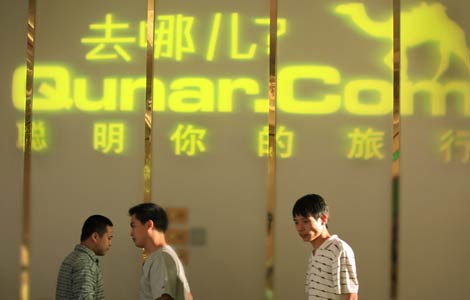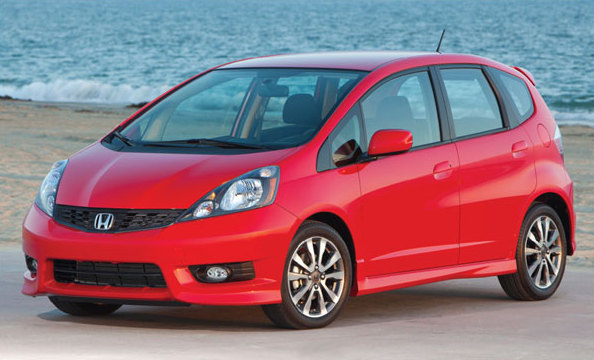Driving the global road
Updated: 2013-11-01 11:59
By Michael Barris (China Daily USA)
|
||||||||
|
In 2011, Japan's Honda Motor Co began importing its Fit subcompact car into Canada from a plant in China, but the company said it has no plans to supply dealers in the United States with Chinese-made Fits. Provided to China Daily |
Fits in Canada
To date, the only Chinese-made vehicles exported to North America are small trucks and off-road vans such as the Wuling Minimax. In 2011, Japan's Honda Motor Co began importing its Fit subcompact car into Canada from a plant in China, but there are no plans to supply dealers in the United States with Chinese-made Fits, according to John Mendel, executive vice-president of American Honda. Honda is building a plant in Mexico that is scheduled to start assembling the Fit for the US and other countries in early 2014.
Honda has been exporting the Fit from China to 27 countries, mainly in Europe where it is sold as the Jazz, for about five years. Nevertheless, Michelle Krebs, a senior analyst with Edmunds.com, an automotive research website, was quoted by the New York Times as saying that Honda and other automakers would have a more difficult time selling cars assembled in China to Americans than to Canadians or Europeans.
"Canada's always been much more open to cars from places that were not acceptable for the US," Krebs said. "Honda has a production system that it uses every place in the world. Consumers can be pretty confident that the same standards apply."
Although made-in-China products are common in the US, most cost a small fraction of the price of a car. Even established automakers like Honda are hesitant to risk turning off buyers with Chinese imports, particularly because the United States is an important source of profit and prestige.
Analysts note that American car buyers were largely skeptical of Japanese and Korean vehicles in their early days here and would tend to react similarly to models made in China, at least initially. A study earlier this year by the consulting firm GfK Automotive found that about one-third of Americans were open to buying a car from China. Younger respondents were more amenable.
The Honda imports are seen as significant because vehicles are among the few categories of consumer products in North America for which manufacturers had not turned to China to try to cut costs.
All the major automakers have plants in China, which they generally use to make vehicles to sell there. Only 3 percent, or 580,000, of the vehicles built in China last year were exported. Many automakers are reluctant to use that capacity to supply other countries because they want to maximize sales in China, now the world's largest car market.
Although China has been a net exporter of vehicles since 2005, and its exports have grown, it exports - and imports - relatively few motor vehicles. Its exports - which are growing much more rapidly than imports - are mostly light trucks and passenger cars shipped to developing country markets.
Employees with Chinese automotive firms in the US know they have their work cut out for them in catching up to the US and other Western nations in vehicle design.
Su with the Chinese automaker Changan, said he has hired about 20 engineers with US auto industry experience in the last few years because of their expertise in developing vehicles.
Little experience
"In China, at original equipment manufacturers, the senior people - even managers and directors in engineering - have less than 10 years, 15 years' experience," Su told China Daily in an interview at his office in July. "And most of that experience is in reverse-engineering, or copying. They don't have vehicle-development experience."
Su chuckled as he said the youngest engineer at his US R&D center, which focuses on chassis design, has 19 years of Detroit industry experience - more than some senior managers in China. His most senior employee, now retired, had 35 years' experience.
China has reverse-engineered many cars, but even creating a copy requires vehicle-development know-how, Su said. "Vehicles have copyright issues; sometimes you are forced to modify. If you don't know the principles of how to modify, you can't do it."
Vehicle-development expertise is necessary to make automobiles that meet performance and quality expectations of today's buyers, he said.
"You can never copy the technical know-how," Su said, as he showed the prototype of the large sedan that Changan, traditionally a maker of smaller cars, plans to build and sell in China.
Su said he believes the US may have to wait five to 10 years to see the first Chinese car sold here, given the engineering techniques typically demanded by developed nations, including pollution-control and safety features.
Matching the level of quality in well-known vehicle brands is especially important because any China foray into the US market would involve taking on a formidable segment of the US auto industry - the used car market.
"It's difficult for non-global automotive brands to sell in the US because the used car market in the US is three times bigger than the new vehicle market," Dunne said. "If someone is looking for inexpensive and reliable transportation, they may opt for a used three- to four-year-old car from a well-known global brand, rather than a new vehicle from an unknown brand."
Some analysts see China's increasing prominence as a supplier as a pathway to gaining knowledge to design US-quality level cars.
China began emerging as a major supplier as increasing vehicle purchases in the ever-prosperous country sparked demand for the estimated 15,000 parts that go into a typical motor vehicle.

 New road links remote Tibet county to rest of the country
New road links remote Tibet county to rest of the country
 Tan Dun premieres new work with Philadelphia Orchestra
Tan Dun premieres new work with Philadelphia Orchestra
 Two firms to debut in US at higher prices
Two firms to debut in US at higher prices
 Women fight to become China's next oceanauts
Women fight to become China's next oceanauts History under a new light
History under a new light
 Kung fu master becomes hit online
Kung fu master becomes hit online
 Color-blind love
Color-blind love
 Lenovo's new secret weapon: Hollywood star
Lenovo's new secret weapon: Hollywood star
Most Viewed
Editor's Picks

|

|

|

|

|

|
Today's Top News
China securitization plan to include foreign banks
Firms heading home as benefits wane in China
China's PMI growth hits 18-month high
China 'urges' US to explain phone taps
Obama: US is open for business
US students compete in Chinese
China condemns Japan's 'dangerous provocation'
Freer RMB 'can answer US claims'
US Weekly

|

|







